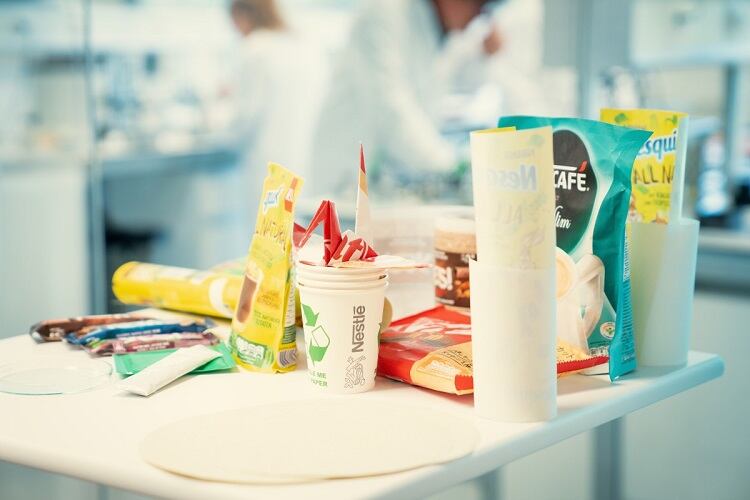Nestlé’s Institute of Packaging Sciences is the 'first-of-its-kind' in the food industry and operates as part of Nestlé Research in Switzerland.
The new facility is home to around 50 people, including around 20 new positions, while Nestlé Research in Switzerland boasts 800 employees and 340 labs, as well as a new R&D accelerator on the campus to support collaboration between academia, start-ups and suppliers.
“The research centre is the largest fundamental research centre in the food industry,” Isabelle Bureau-Franz, head of research at the Swiss food giant explained during the inauguration event.
The scale of the facility stands testament to Nestlé’s determination to re-invent its relationship with plastic. The Nescafé-to-Kit Kat manufacturer has said it aims to switch to 100% reusable or recyclable plastic by 2025. Announcing the target earlier this year, Nestlé stressed that there is an ‘urgent need to minimize the impact of packaging on the environment’.
Speaking at the launch event, chief executive Mark Schneider explained: "Our vision is a world in which none of our packaging ends up in landfill or as litter.”
Schneider explained that the company’s approach is three-fold. “To realise our 2025 commitment, we need to discover and scale up innovative technical solutions, address infrastructure challenges and incentivise new behaviours.”
Alongside encouraging consumers to adopt new behaviours through its brand communications and supporting the development of recycling infrastructure, Nestlé is using its innovation capabilities to develop packaging that preserves the safety and freshness of food while minimising environmental impact.

The Institute of Packaging Science is an integral part of this ambition. As Schneider put it, here Nestlé is developing the ‘packaging of the future’.
“We want to be in the driver’s seat when it comes to developing more sustainable packaging for our products. Our good name is on the packaging and we owe it to our consumers to do more.” - Mark Schneider
Nestlé five focus areas spotlight materials innovation
So, what does the ‘the packaging of the future’ look like?
Nestlé chief technology officer, Stefan Palzer, stressed that making progress on this topic is of high importance for Nestlé Research. “Plastic

waste and mitigation of climate change through cutting edge technologies and product design are a priority for us. We will out everything it needs behind this objective,” he said at the facility in Lausanne, Switzerland. “It will require a portfolio of solutions, which are science-based.”
The company is focusing on five different areas. Firstly, it is developing ‘reusable packaging solutions’ such as refillable containers and delivery systems that require zero packaging, Palzer explained.
Demonstrating some of the options Nestlé is exploring – from water to Nescafe dispensers to reduce single-use, single serve items - Gavin Steiner, head of R&D for packaging, said these developments have the potential for a ‘big impact’.
However, while innovation in this area might sound like a no-brainer, it is actually quite a complex proposition that requires the development of ‘circularity’ between manufacturers, retailers and consumers.
“We are looking at alternative systems. They come with their own challenges around quality and safety,” Steiner noted.
The second focus area, Palzer explained, developing packaging that feeds more easily into existing recycling infrastructure. “We are also simplifying our packaging to make it easier to recycle, we are eliminating packaging components and packaging layers. We are employing new technologies enabling us to increase the recycled content in our packaging.”
Alongside developing plastics that are simpler and therefore easier to recycle, the company is using its scientific prowess to produce ‘high performing’ alternative packaging barrier materials, such as barrier papers. This approach can already be seen in action in Nestlé’s Yes! Bars and Nesquik Natural lines. “This is really a new generation of packaging materials that do not exist in the market,” Palzer enthused.
Finally, Palzer said that the company wants to push the envelope with its research into biopolymers. “This is very exciting for us. We are pioneering biopolymers which are biodegradable and which degrade in the composting environment.”

Research chief Bureau-Franz was equally buoyant about this new area for Nestlé’s packaging research. She stressed that it was possible thanks to the multi-disciplinary approach that the company is taking and its collaborative platform with suppliers, start-ups and academic institutions.
“There are key synergies with different scientific experts… To give you an example, when we speak about food safety it is vital to understand the collaboration between packaging experts, food scientists, and how they will ensure any alternative packaging solution will be safe and protect the food in terms of taste, texture. This is one of the key challenges.
“Those scientists are starting to understand and work out how different microorganisms could interact with packaging materials and this is opening the door on a huge area which is the development of biodegradable packaging.”
Sander Koster, group lead on packaging food safety, echoed that Nestlé is uniquely positioned with the expertise to both develop new bio-based materials and also ensure that they are safe. Working with bio-based, fibre based or recycled packaging ‘will bring new food safety challenges,’ he stressed.
“It is an exciting and for sure challenging period.”

